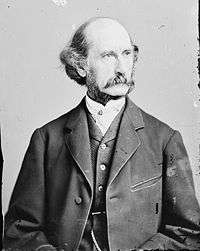Lafayette S. Foster
| Lafayette Sabine Foster | |
|---|---|
 | |
| United States Senator from Connecticut | |
|
In office March 4, 1855 – March 4, 1867 | |
| Preceded by | Francis Gillette |
| Succeeded by | Orris S. Ferry |
| President pro tempore of the United States Senate | |
|
In office March 7, 1865 – March 2, 1867 | |
| Preceded by | Daniel Clark |
| Succeeded by | Benjamin Wade |
| Mayor of Norwich | |
|
In office 1851–1852 | |
| Preceded by | William Alfred Buckingham |
| Succeeded by | William Alfred Buckingham |
| Member of the Connecticut House of Representatives | |
|
In office 1839-1840 1846-1848 1854 | |
| Personal details | |
| Born |
November 22, 1806 Franklin, Connecticut, US |
| Died |
September 19, 1880 (aged 73) Norwich, Connecticut, US |
| Political party | Whig, Republican |
| Spouse(s) | Joanna Boylston Lanman Foster |
| Alma mater | Brown University |
| Profession | Politician, Lawyer, Judge, Teacher, Editor |
Lafayette Sabine Foster (November 22, 1806 – September 19, 1880) was a nineteenth-century American politician and lawyer from Connecticut. He served in the United States Senate from 1855 to 1867 and was a judge in the Connecticut Supreme Court from 1870 to 1876.
Born in Franklin, Connecticut, Foster attended common schools as a child and graduated from Brown University in Providence, Rhode Island, in 1828. He taught school in Providence for some time and studied law back in Norwich, Connecticut. He took charge of an academy in Centerville, Maryland, where he was admitted to the Maryland bar in 1830, then returned to Norwich and was admitted to the federal bar in 1831.
Foster was editor of the Republican, a Whig newspaper out of Connecticut, and served in the Connecticut House of Representatives from 1839 to 1840, 1846 to 1848 and 1854, serving as Speaker of the House for three years. He was the Whig nominee for Governor of Connecticut in 1850 and 1851, but lost both elections. He served as mayor of Norwich, Connecticut, from 1851 to 1852 before being elected as an Oppositionist to the United States Senate in 1854, and reelected in 1860 as a Republican, serving from 1855 to 1867. There, he served as chairman of the Committee on Pensions from 1861 to 1867. His wife, Joanna Boylston Lanman, died on April 11, 1859.
Foster was elected President pro tempore of the Senate at the beginning of the 39th Congress in 1865, and held that title until the end of his term in 1867. Six weeks after he was elected, President Abraham Lincoln was assassinated by John Wilkes Booth. Two of Booth's accomplices also intended to assassinate Vice President Andrew Johnson as well as Secretary of State William H. Seward. Seward's assassin, Lewis Powell, struck but failed to kill, whereas Johnson's assassin, George Atzerodt, never acted. If Atzerodt had assassinated Johnson, Foster would have been Lincoln's successor as President of the United States. With Johnson's elevation to the presidency, Foster instead became first in line of succession.
Foster was defeated for reelection for a third term in 1866 and left the Senate the next year. He became a professor of law at Yale College in 1869 and returned to the Connecticut House of Representatives in 1870. He was once again elected Speaker of the House, but resigned to take a seat on the Connecticut Supreme Court. He was a Democratic candidate for the United States House of Representatives in 1874, but was unsuccessful and resigned from the court in 1876, retiring from public life.
Foster died in Norwich, Connecticut, on September 19, 1880, and was interred there in Yantic Cemetery.
References
External links
- United States Congress. "Lafayette S. Foster (id: F000308)". Biographical Directory of the United States Congress.
- Lafayette S. Foster at Find A Grave
| United States Senate | ||
|---|---|---|
| Preceded by Francis Gillette |
U.S. Senator (Class 3) from Connecticut March 4, 1855 – March 4, 1867 Served alongside: Isaac Toucey and James Dixon |
Succeeded by Orris S. Ferry |
| Political offices | ||
| Preceded by Daniel Clark |
President pro tempore of the United States Senate March 7, 1865 – March 2, 1867 |
Succeeded by Benjamin Wade |
![]() This article incorporates public domain material from the Biographical Directory of the United States Congress website http://bioguide.congress.gov.
This article incorporates public domain material from the Biographical Directory of the United States Congress website http://bioguide.congress.gov.

